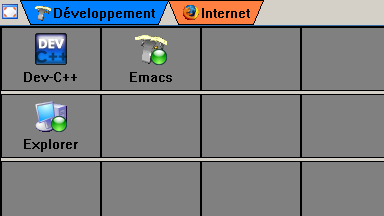Project hosted by 
See the Project page for download links.
TOC
Introduction

DropBar is an Application Desktop Toolbar, much like the
regular Taskbar, intended for those of us who have too many
windows open at once and want to organize them in a more
customizable fashion than just buttons in the Taskbar.

In order to achive this, DropBar is organized in several
tabs, each one containing several applications shown as both
icon and label. Most operations are done through drag and
drop.
This document will guide you to setup DropBar and learn about
its features. Don't forget that DropBar is a work in progress
and probably has some bugs and limitations.
Basics
When you first launch DropBar, no tabs are created by
default. Yet you can see three buttons, one on the left side and
two on the right side. The left side button, when clicked,
maximizes the currently active window. This button is placed on
the very left side, so that you can throw your mouse at it
without aiming and click.

On the right side, you get a button to minimize the active
window, and one to close it. Same remark here; throwing your
mouse at the top-right side of the screen and clicking will
close the active window. There is no such facility for the
minimize button, a rectangle has too few corners :)

Adding and configuring tabs
Right-clicking on the bar show a context menu that allows you
to add a tab (you can also quit the application from here). A
newly added tab is empty and has a label 'New panel'.

To edit the tab's settings, just right-click on it and choose
"Edit tab settings". This will pop up the following dialog
box.

From here, you can change the following values:
- Background colour: The tab's colour.
- Text colour: The tab's label colour.
- Text: The tab's label.
- Icon: An icon to display on the left of the label. This
may be an .ico file or an .exe file.
Adding and configuring applications
You noticed that when you move the pointer over a tab, a
window opens, splitten in gray rectangular areas. These are the
places where applications will be displayed. To add an
application in one of the rectangles, just drag and drop it (or
even a shortcut) to the target rectangle. The application's icon
becomes visible, as well as the program's name.

Clicking on this rectangle launches the application. When the
corresponding program is running, a green LED show it. Then,
clicking on the rectangle has the following effect:
- If the application has only one window, it is restored.
- If it has several windows, a menu pops up, holding all of these and
letting you choose which one you want restored.


You can drag and drop the application to move it to another
rectangle. You can also drag and drop it to a rectangle in
another tab.
Right-clicking on an application pops up a menu with two
items: "Empty", which deletes the application from this
rectangle, and "Settings", which pops up the following
dialog:

You can configure the following items:
- Name: The label under the icon.
- File: The application executable. This also determines
the icon.
- Drop command: This is the command that is launched when
you drop a file to the application. More on this later.
- Background color: Background color of the rectangle.
Drop commands
You can drag and drop any file to one of DropBar's
applications. By default, it will try to launch the application,
passing it the file name as parameter. You can customize this
behaviour by setting the drop command in the application's
configuration. The command must contain a "%s" specifier, which
will be replaced with the dropped file name. Some examples:
Windows explorer
Drag explorer.exe from your Windows directory to an empty
rectangle. Edit the settings. Change the drop command to
C:\Windows\explorer.exe /e,"%s"
Now, each time you drop a directory to the explorer's
rectangle, it will open a new window in explorer mode, open in
this directory.
Emacs and gnuclient
If the application is Emacs, and you have Gnuserv installed,
you may want to change the drop command to
<path>\gnuclientw.exe "%s"
in order to drag & drop documents on the Emacs icon and have
them open in your existing Emacs instance.
Credits
Thanks to David Vignoni for making the Nuvola icon set
available.
The original idea comes from a MacOS shareware named DragThing, which I
discovered through Tog's
blog since I don't own a Mac.









